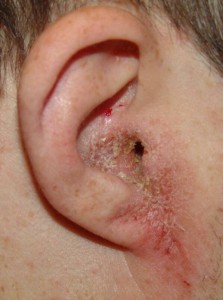Otitis Externa (Swimmer’s ear) is an inflammation of the outer ear and ear canal. It is a common problem worldwide presenting to General Practitioners particularly in coastal temperate and tropical Australia.
The skin in the external ear canal of a healthy ear has a thin protective coating of cerumen, a mixture of secretions from apocrine and sebaceous glands mixed with desquamated epithelial cells. Interruption or alteration of this protective layer by trauma and /or exposure to moisture may result in inflammation. Many factors such as genetic (shape and size of ear canal, effectiveness of immune system, concomitant dermatological illness), environmental (tropical climate), occupational (hearing protection and / or humid working conditions), recreational (water sports) and personal hygiene (use of ear buds, attempts at cleaning the ear canal with water) facilitate the development of such inflammation. This inflamed skin may secondarily get infected. However, in at least one third of patients an infectious organism cannot be found. In the other two thirds it is not always clear if the found organism is causing the signs and symptoms or, if it quietly resides in the ear canal and is found by mistake. However, in severe cases a secondary infection is likely.
Common consequences for the patient of otitis externa are pain, sleep disturbance, temporary loss of hearing, pharmaceutical and consultation expenses, and perhaps loss of income. Initial symptoms at presentation to medical practices range from mild irritation with almost no pain to strongest pain imaginable. The most common outcome of otitis externa is full recovery after 5-14 days. In the meantime pain makes it difficult to maintain work or leisure activities. In rare cases severe damage to the pinna, outer and middle ear may sometimes result in significant hearing loss. In these severe cases infection may also spread to deeper structures such as the inner ear and the brain threatening the patient’s life.
The current standard treatment for otitis externa is usually topical (ear drops) and in selected cases also oral antibiotics. Ear drops are usually a combination of corticosteroids and antibiotics. Corticosteroids is an anti inflammatory drug that reduce the immune response. Hence, corticosteroids given to a patient having a severe infection might put the patient into a worse situation. However, it is shown that corticosteroids can be given safely and with beneficial effect to patients having an ongoing infection of low or moderate virulence. Examples are patients with croup and the sore throat.
The objective of the present study is to assess the efficacy of low dose oral corticosteroids for four days in addition to conventional therapy in the management of painful acute otitis externa.
